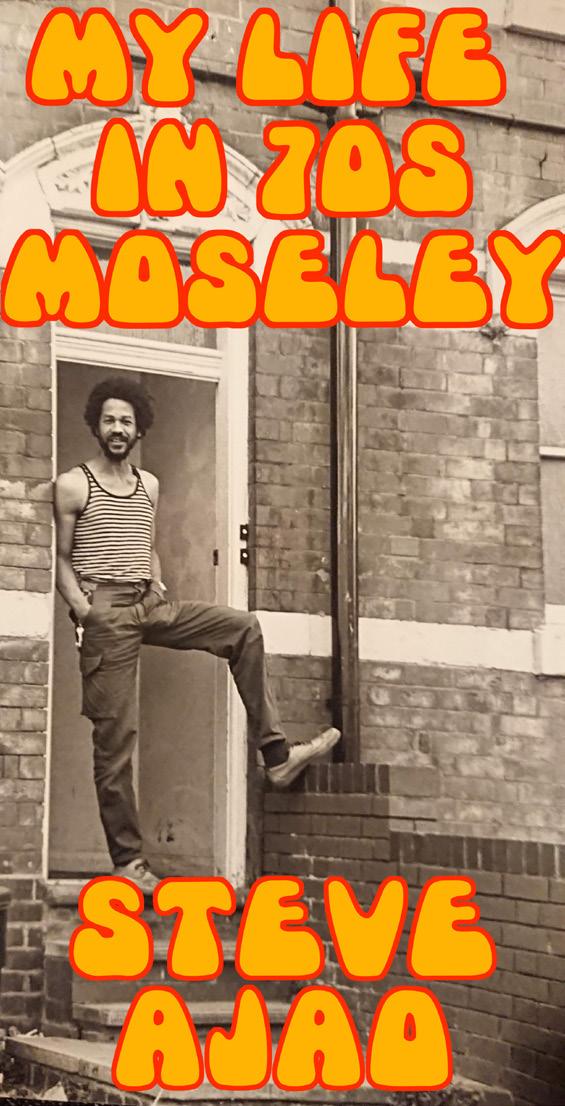
4 minute read
STEVE AJAO
After graduating from the Lanchester Polytechnic Arts Faculty in Coventry, I was back in Birmingham. It was 1973 and I headed straight to Moseley where I knew I would soon find kindred spirits. Before going to Art College I had been at Moseley Art School in the ‘60s, so to me, Moseley seemed the obvious choice. I had been playing lead guitar with my Dad’s band, largely to support myself when I was a student, and I was eager to form a bluesy rock band. Back then, Birmingham had numerous venues, pubs, clubs and university gigs and it was fairly viable to make a living. I soon ended up jamming with all kinds of musicians, and formed bands such as 'The First Band' and the 'Wide Boys' around that time. For a short while, I had a single room in St Albans Road, in Moseley. It was pretty rough there so I often used to eat cheaply in the canteen at Margaret Street Art College in town. I wasn’t a student there, but I had a Hendrix inspired image - afro, flares and beads - so I fitted well into the scene, every day. Back then, most art students looked as if they had just got back from Woodstock. I soon met a few new friends, and we would talk about art and music, and generally all the things enjoyed by hippy types. I remember meeting a very young, clean-cut painting student at the college - Dave Hinds - who years later became the lead singer and founder member of Steel Pulse. He was friendly, but I felt that he was a little wary of me and thought I was some kind of wild man because of my appearance! Strange that might seem, if you look at him now.
Stan, one of my new friends, invited me to move into his shared rented house as there was a spare room. The house was at 39 Chestnut Road, Moseley, and my room was in the rear of the ground floor flat. Stan, a painter, lived in the front, surrounded with his paintings. On my first morning there I woke up to see a mouse leap off my blanket and dash behind the fireplace. It was a typical Victorian terraced house, and the inside was rough, but in a very cosy, rustic way. The five of us who lived there customised our rooms with tatty furniture (Moseley was full of large houses which had been empty for years, and were great sources of furniture) - shelving, lighting and art works. After a while, the mice seemed unperturbed by us humans; they went about their business and we went about ours. Every day was spent painting, playing instruments or
Advertisement

talking well into the early morning hours. In fact, it was quite common for us to walk up to the dairy in Woodbridge road, not long after dawn, to get cool fresh milk and yoghurt. The house had a small garden at the front, which was planted with coriander and you could smell it as you approached. Our Asian neighbours smelt it too, and would pick a little of it. To show their gratitude, they would give us bowls of delicious homecooked curry and chapattis. They would shout over the fence “Hey hippies, you want curry?” The rear garden was wonderful. It was completely cultivated, like an allotment. Row after row of tall cane frames with beans, tomatoes, and all kinds of edibles, were tended to by all housemates. Upstairs, John, an abstract painter, and his wife, Kate, would often announce that the bread they had just made was ready, should anybody want some. Who could resist that? The smell and flavour of that bread was delightful, and the home-made garden-jam, or garden-pickle was perfect with it. We lived there throughout the 70s, and in all that time our food bill was negligible.

It seemed we knew everyone in Moseley Village; we liked to drink in the Prince, the Fighting Cocks (where I often played upstairs) the Bull’s Head, the Malt Shovel, the Moseley Arms, the Barrel Organ (another favourite venue) and the Golden Eagle in town. There were legendary Moseley parties most weekends, before extended licensing in pubs became the norm. Nobody ever needed an invitation. Eventually, we all went our different ways. John and his wife found an ancient stone cottage near Bala in Wales. They lived there, austerely, with no electricity or gas, with a well for water and a hole-in-the-ground for a loo. It was pretty tough staying at theirs! Others moved into the old Victorian homes done up into flats by Moseley and District Church Housing, or went to live in Bristol or London. I stayed in Moseley at various addresses over the years, before moving up the road to Kings Heath. For the most part, I thoroughly enjoyed my life in ‘70s Moseley and it has had a profound effect on me. - Steve Ajao










